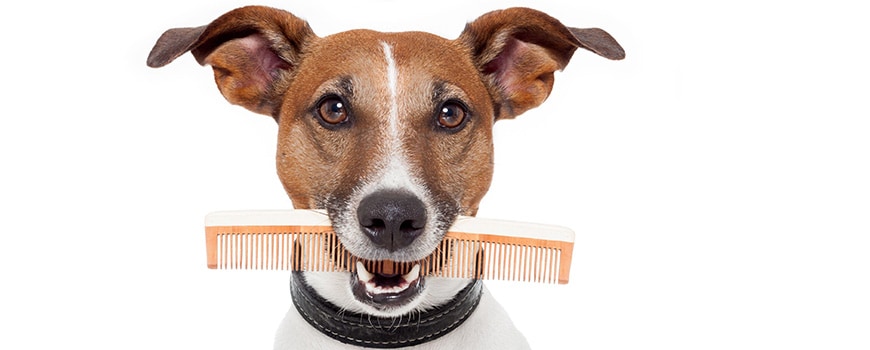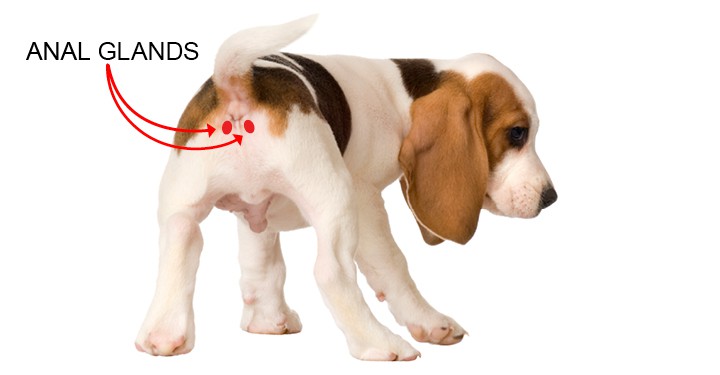Anal Glands
These sacs or “scent glands” are situated on either side of the anus. They are inversions of skin where it joins the end of the digestive tract. The cavity formed is quite large and collects fluid. If it becomes blocked, the dog may show various signs of irritation:
- Rubbing his bottom along the floor
- Biting at the area
- Flying around in circles to bite his tail
- Snappy or oversensitive when you want to touch his quarters
- Hanging his tail, instead of carrying it high, sometimes tucking it well between his legs.
Other dogs seem not to show adverse signs, but are particularly smelly.
Where dogs are allowed frequently to chew raw bones, enough calcium deposit is expelled to harden the feces and the sac is emptied naturally. However, with today’s trend of feeding less natural diets, more and more dogs need their glands emptied for them. If they are not emptied, abscesses can form. Bitches, after a season, usually benefit from having their anal glands emptied.
This is a job for the professional; not to be undertaken by a novice pet owner. Some vets claim this procedure should only be done by a vet; others feel groomers should handle it.
Checking
While the dog is in the bath, it is a good time to check his anal glands. If warm water is applied to the area, this tends to soften the skin and relax the dog, often making the emptying of the gland easier. With neglect of this procedure, an abscess may form, causing veterinary bills as well as severe discomfort for the dog. Squeezing the glands externally quickly performs this service.
Procedure
Use a fine-rubber hygiene glove and absorbent paper towel, and place your finger and thumb on either side of the anus. You
will be able to feel the hardened gland about 1 inch (2.5 cm) in. Press in, up and outwards to expel the vile-smelling fluid, which is sometimes almost as thick as toothpaste, and sometimes as liquid as water.
There is a knack to this and some dogs’ glands are far easier to empty than others. If the area is very sensitive or smelly, or both, and nothing comes away, it is as well to advise the client to take the dog to the vet to have this area checked out in case something more sinister has developed.
Nails
Once the dog is bathed (before or after drying the coat) and is sitting on the table, this is a good time to trim back your dog’s nails, as they are softened by the water and are usually easier, and less brittle, to snip. Some dogs have long blood vessels in their nails because the nails have not been trimmed back on a regular basis since puppyhood and very little nail can be cut. Using a large file or electric file is often safer in these cases.
However, electric filers often wind themselves up in long, loose coats. Breeds such as the Afghan or the American Cocker should be manually filed.
The “quick” is the nerve and blood supply in the nail. If this is cut, it will be very painful to the dog, and may become infected. Stop bleeding using a styptic pencil or permanganate crystals. Care should be taken with nails; it causes the dog severe pain when the quick is cut.
If the nails of a nervous or ticklish dog need cutting, then arrange for somebody to hold the dog and talk to it while you quickly carry out the task. Often, such dogs can have their nails filed without objection.
Dewclaws
Dewclaws are a problem in some active dogs because they can easily get torn away from the foot. Some dogs, such as the Poodle, have dewclaws removed at birth, while others, such as the Great Pyrenees, have a breed standard that requires these extra toes.
Dewclaws should be checked on a regular basis, as the nail can grow and grow, and may even grow back into the leg. This causes considerable pain to the dog and can result in infections, to the point where surgery is the only answer.
In the pet dog, dewclaws are not required at all. If they have been left on, they cannot be removed unless by a major operation. The nail of the dewclaw, however, can be clipped back with the rest of the nails. The less roadwork the dog does, the more likely it is that the nails will regularly need cutting or filing back (at least every three months).
Some dogs have poor feet, where the nails turn before they reach the ground. Such dogs will need their nails to be clipped back more often than others.
Check the dewclaws every week when you look at your dog’s nails. Puppies that have dewclaws need to have these clipped at the same time as you cut their sharp little needle-like nails.
Ears
Holding the ear flap back, clean the ears with alcohol or ear cleaner if necessary and apply ear powder to ensure the ear stays healthy and mite-free. After applying ear powder and leaving it in for a few minutes, use forceps to clean the hair from the ear, removing tiny bits of hair at a time. This will be less painful than using fingers.
Make sure that you clean the forceps with alcohol before and after each dog, to ensure that you do not spread infection or mites.
Eyes
Keep the eyes clean, checking routinely for any sleep deposits or any weeping ducts. Use damp cotton batting to remove any accumulation or this will form a hard lump and could develop into a sore.
Teeth
A dog’s teeth should be routinely checked when visiting a professional groomer so early problems, such as a decaying tooth, can be detected before they become advanced. Accumulation of tartar in dogs that have soft diets of processed food can create a problem. Left neglected, it can cause gum disease and tooth decay.
If your dog is not fed safe, raw bones, his teeth will need regular brushing to remove plaque. If the mouth looks red and infected, or smells offensive, then a vet should be consulted.
Tartar Removal
If tartar has built up, this can be removed with a tooth scraper, provided that the problem has not accumulated out of control. The tooth scraper is a fine, long-handled tool with a flat edge rather like a miniature spade.
- Before use, the scraper is cleaned with peroxide.
- To scrape away plaque, hold the dog’s muzzle in one hand, lift the flap of the mouth and chip away at the tartar. This can be difficult at first, but when the initial hard lump falls away, the rest usually comes away easily.
- Next apply an astringent. A solution of half peroxide and half water (or a purpose-made mouth astringent from the vet) to clean the gums before and after chipping off the tartar is always advisable, to prevent infection.
- Dip a cotton pad into the solution and gently rub into the gums.
Do not undertake this procedure without first making sure that you are legally allowed to do so. In some places in the U.S., it can be illegal for professional pet groomers to scrape teeth, as it is considered the practice of veterinary medicine. In such places, groomers are allowed to brush teeth but not to scale them. If in doubt, contact your national grooming organization for advice.
Teeth Stains
Rings of brown staining can appear on the teeth. Some believe these rings are a reaction to vaccines or to water quality. Whatever their cause — whether they are inherited or caused by illness — these stains will not be removed by any means. Often, the top of the tooth will also have a brown edge.
So, before you take a tartar descaler to your dog’s teeth, check beforehand, as brown discoloration will not be removed. In fact, tartar accumulation is normally cream or beige in color, sometimes with a darker brown edge near to the gum.


